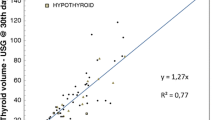Abstract
Background and aims: The success of I-131 therapy in geriatric patients who were referred to an endocrinology clinic with toxic nodular goiter and who lived in iodine-deficiency regions was studied. Materials and methods: Patients older than 60 years who received I-131 therapy were included via retrospective data analyses. Fifty-nine patients between 60 and 82 years of age were enrolled in the study. The patients received an oral capsular form of I-131 (10–25 mCi) and were followed up for 1 year with clinical and laboratory results. Euthyroid or hypothyroid status at the end of the year after treatment was deemed to be a response to treatment. Results: Of the 21 (36%) male and 38 (64%) female patients, 29 (49%) had a solitary toxic nodule and 30 (51%) had toxic multinodular goiter. Twenty-nine (49%) of the patients received propylthiouracil therapy. At the end of the year, 38 (64%) patients were euthyroid, 11 (19%) were hypothyroid, and 10 (17%) were thyrotoxic. Forty-nine (83%) patients who were euthyroid and hypothyroid were considered responders. Conclusion: Geriatric patients with toxic nodular goiter were shown to have a high response rate to I-131 therapy. Thus, we suggest that radioactive iodine treatment should be the first-line treatment in these patients.
Similar content being viewed by others
References
Franklyn JA. The management of hyperthyroidism. N Engl J Med 1994; 330: 1731–8.
Tunbridge WM, Evered DC, Hall R, Appleton D et al. The spectrum of thyroid disease in a community: the Whickham survey. Clin Endocrinol (Oxf) 1997; 7: 481–93.
Laurberg P, Pedersen KM, Vestergaard H, Sigurdsson G. High incidence of multinodular toxic goitre in the elderly population in a low iodine intake area vs. high incidence of Graves’ disease in the young in a high iodine intake area: comparative surveys of thyrotoxicosis epidemiology in East-Jutland Denmark and Iceland. J Intern Med 1991; 229: 415–20.
Erdogan MF, Atli T, Ekinci C, Genç Y, Gökmen H, Erdogan G. Orta derecede iyot eksikligi olan bir bölgede yasayan yaslilardaki tiroid hastaliklari spektrumu ve prevelansi. Turkish Journal of Geriatrics 2002; 5: 49–53.
Ustun F, Yuksel M, Durmus-Altun G et al. The incidence of recurrence and hypothyroidism after radioiodine treatment in patients with hyperthyroidism in Trakya, a mild iodine deficiency area, during the period 1991–2003. Ann Nucl Med 2005; 19:737–42.
Assey VD, Greiner T, Mzee RK et al. Iodine deficiency persists in the Zanzibar Islands of Tanzania. Food Nutr Bull 2006; 27: 292–9.
Zimmermann MB, Jooste PL, Pandav CS. Iodine-deficiency disorders. Lancet 2008; 372: 1251–62.
Mosekilde L, Eriksen EF, Charles P. Effects of thyroid hormones on bone and mineral metabolism. Endocrinol Metab Clin North Am 1990; 19: 35–62.
Cobler JL, Williams ME, Greenland P. Thyrotoxicosis in institutionalized elderly patients with atrial fibrillation. Arch Intern Med 1984; 144: 1758–60.
Trivalle C, Doucet J, Chassagne P et al. Differences in the signs and symptoms of hyperthyroidism in older and younger patients. J Am Geriatr Soc 1996; 44: 50–3.
Ronnov-Jessen V, Kirkegaard C. Hyperthyroidism: a disease of old age? BMJ 1973; 1: 41–3.
Cooper DS. Antithyroid drugs. N Engl J Med 2005; 352: 905–17.
Jain K, Chakrapani M, Smitha K. Acute cholestatic hepatitis along with agranulocytosis: a rare side effect of carbimazole. Ann Afr Med 2010; 9: 102–4.
Vilchez FJ, Torres I, Garcia-Valero A, Lspez-Tinoco C, de Los Santos A, Aguilar-Diosdado M. Concomitant agranulocytosis and hepatotoxicity after treatment with carbimazole. Ann Pharmacother 2006; 40: 2059–63.
Clerc J, Dagousset F, Izembart M et al. Radioiodine therapy of the autonomous thyroid nodule in patients with and without visible extranodular activity. J Nucl Med 1995; 36: 217–23.
Van Soestbergen MJM, Van der Vijver JCM, Graafland AD. Recurrence of hyperthyroidism in multinodular goiter after longterm drug therapy: a comparison with Graves’ disease. J Endocrinol Invest 1992; 15: 797–800.
Hoekstra HJ. Cancer surgery in the elderly. Eur J Cancer 2001; 37(Suppl 7): 235–44.
Türkmen A, Turgut N. Geriatrik anestezi. Turkish Journal of Geriatrics 2007; 10: 49–56.
Tarantini B, Ciuoli C, Di Cairano G et al. Effectiveness of radioiodine (131-I) as definitive therapy in patients with autoimmune and non-autoimmune hyperthyroidism. J Endocrinol Invest 2006; 29: 594–8.
Reiners C, Schneider P. Radioiodine therapy of thyroid autonomy. Eur J Nucl Med Mol Imaging 2002; 29 (Suppl 2): 471–8.
Çinar N, Gürlek A. The reliability of radioiodine treatment in the long term. Turkiye Klinikleri J Endocrin-Special Topics 2008; 1: 71–8.
Luster M, Verburg FA, Scheidhauer K. Diagnostic imaging work up in multi-nodular goiter. Minerva Endocrinol 2010; 35: 153–9.
Okosieme OE, Chan D, Price SA, Lazarus JH, Premawardhana LD. The utility of radioiodine uptake and thyroid scintigraphy in the diagnosis and management of hyperthyroidism. Clin Endocrinol (Oxf) 2010; 72: 122–7.
Allahabadia A, Daykin J, Sheppard MC, Gough SC, Franklyn JA. Radioiodine treatment of hyperthyroidism — prognostic factors for outcome. J Clin Endocrinol Metab 2001; 86: 3611–7.
Hancock LD, Tuttle RM, LeMar H, Bauman J, Patience T. The effect of propylthiouracil on subsequent radioactive iodine therapy in Graves’ disease. Clin Endocrinol 1997; 47: 425–30.
Imseis RE, Vanmiddlesworth L, Massie JD, Bush AJ, Vanmiddlesworth NR. Pretreatment with propylthiouracil but not methimazole reduces the therapeutic efficacy of iodine-131 in hyperthyroidism. J Clin Endocrinol Metab 1998; 83: 685–7.
Jarlov AE, Christensen E, Hegedüs L, Kristensen LØ, Nygaard B, Hansen JM. Factors associated with recurrence of hyperthyroidism after 131I treatment: the inadvertent influence of antithyroid drug administration after 131I treatment of hyperthyroidism. Thyroidology Clin Exp 1997; 9: 55–9.
Author information
Authors and Affiliations
Corresponding author
Rights and permissions
About this article
Cite this article
Erkan, M.E., Demirin, H., Aşık, M. et al. Efficiency of radioactive I-131 therapy in geriatric patients with toxic nodular goiter. Aging Clin Exp Res 24, 714–717 (2012). https://doi.org/10.3275/8759
Received:
Accepted:
Published:
Issue Date:
DOI: https://doi.org/10.3275/8759




